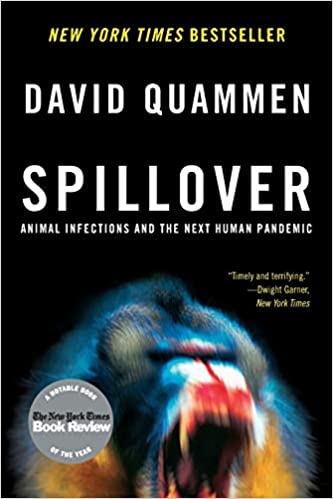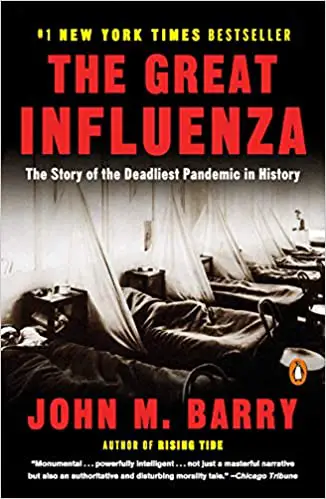
In the past two months, we’ve learned more about viruses than we ever wanted to know. Thank the coronavirus for this. This pandemic has turned us all into ‘experts.’ What is the nature of this virus? How is it transmitted? Who is at risk? How can we protect ourselves?
While we may be reaching our limits—how much spring cleaning, cooking, and binge watching can we do while we shelter at home—we’ve discovered that learning more about past pandemics is calming. Understanding more about the cause and course of earlier pandemics helps us take the long view during the current crisis. Think Spanish Influenza of 1918, the Black Death of the Middle Ages, Ebola and AIDs.
We have selected a few books on pandemics that are as engaging as they are informative. Not surprisingly, all have become Amazon bestsellers in recent months.
Spillover: Animal Infections and the Next Human Pandemic
by David Quammen
We should have known better. It has happened before. The current coronavirus pandemic is the result of a tiny virus that crossed over from its animal host into humans. Experts label such an event a “spillover” and they warn us to brace ourselves.
Quammen has tracked this subject from the jungles of Central Africa, the rooftops of Bangladesh, and the caves of southern China to the laboratories where researchers work in space suits as they study deadly viruses. He helps us understand the dynamics of Ebola, SARS, bird flu, Lyme disease, and other emerging threats. He tells the story of AIDS and its origins as it has never been told before. Spillover reads like a mystery tale, full of action, memorable characters, clues and questions.
_________________________________________________________
_________________________________________________________
Why read such a scary book now, asks one reviewer. As I was reading, the education, facts, and understanding have helped me cope with the current pandemic crisis. In the end, a lot depends on education, and our responsibility to respect ecology and evolution. Essential reading during the 2020 Coronavirus pandemic.
“Quammen not only provides a warning about the diseases we will face in the future, he also causes us to reflect on our place as humans in the earth’s ecosystem.”
– Walter Isaacson, author of Leonardo Da Vinci
The Great Influenza
by John M. Barry
In 1918, a pandemic swept around the world virtually without warning. It killed healthy young adults as well as infants and the elderly. Hospitals and morgues were quickly overwhelmed. In Philadelphia—the hardest-hit municipality in the US—4,597 people died in one week alone and bodies piled up on the streets to be carted off to mass graves.
In this sweeping history, Barry explores how the deadly confluence of biology (a swiftly mutating flu virus passed between animals and humans) and politics (President Wilson’s all-out war effort in World War I) created the conditions for a virus to run wild. The Great Influenza killed more than 50 million worldwide; as many as 500 million were infected.
_________________________________________________________
_________________________________________________________
Overcrowded military camps and far-flung troop movements enabled the highly contagious flu to spread quickly. Transport ships became “floating caskets.” Still the U.S. government refused to shift priorities away from the war and, in effect, ignored the crisis. For perspective, as many American soldiers were killed by this flu as were killed in battle during World War I.
Shortages of doctors and nurses hurt military and civilian populations alike, and the incompetence of public health officials exacerbated the death toll. Barry skillfully captures the sense of panic and despair that overwhelmed stricken communities. He hits hard on those who failed to use their power to protect the public. He describes the work of dedicated researchers who rushed to understand the disease and create vaccines.
We can thank these researchers for the flu shots that are so widely available today. Barry’s telling of the 1918 influenza shares much in common with the current coronavirus pandemic.
Find The Great Influenza on Amazon.
The Great Mortality
by John Kelly
The Black Death that devastated Europe and Asia in the 14th century is the most fatal pandemic in history. The plague, as it was also known, peaked in Europe between 1347 and 1351. It killed between 75–200 million people—some 30%-60% of the population. It would ultimately take Europe 200 years to recover.
The plague probably originated in Central or East Asia, and travelled along the Silk Road to Crimea in 1347. From there, it was carried by fleas living on the black rats living on the Genoese merchant ships to the Mediterranean Basin, Africa, and Europe.
Statistics do not convey the full horrors of this scourge. So Kelly gives us a human account. What it was like to live in Siena or Avignon and hear that a thousand people a day were dying just two towns over? What would you do if faced with a choice between your own life and that of your dying child or spouse? How did it feel to live in a society where family, social norms and the law had become meaningless, where anyone could murder or rape or plunder without fear of consequence?
[In The Great Mortality], “John Kelly gives the reader a ferocious, pictorial account of the horrific ravages of [the] plague…an emotionally accessible narrative, animated by wrenchingly vivid tableaus and alarming first-hand witness accounts. . . that give the reader an intimate sense of day-to-day life in medieval Europe.” (Michiko Kakutani, New York Times)
Find The Great Mortality on Amazon.
Note to readers: if you purchase something through one of our affiliate links we may earn a commission.
***
You may also like
- Feeling squirrely? 12 ways to stay active when you’re quarantined
- Books for binge reading, perfect in a time of stay-at-home
- How to boost your immunity if you’re over 60
Go to the BLUE HARE home page for more articles for fabulous women



